Judith Francisca Baca was born in 1946 in Watts, a southern Los Angeles district. Her parents were Mexican-Americans, and Watts was largely a Latino and Black community. Judy was immersed in the culture, speaking only Spanish. Her mother remarried, and they moved to Pacoima, a predominately white district of Los Angeles. She was not allowed to speak Spanish in elementary school, isolating her until she became fluent in English. During that time, she was encouraged to sit quietly and draw. After graduating from a Catholic high school in 1964, she went on to earn a bachelor’s degree in fine art in 1969 and master’s degree in 1979 from the California State University, Northridge. Her desire to make art for the people she loved gave her direction: “I thought to myself, if I get my work into galleries, who will go there? People in my family hadn’t ever been to a gallery in their entire lives. My neighbors never went to galleries…And it didn’t make sense to me at the time to put art behind some guarded wall.”
Baca continued her education at La Tallera, in Cuernavaca, Mexico. The school was founded by Mexican artists Diego Rivera and David Siqueiros who had elevated mural painting to an international level. According to Siqueiros, “The space was born of an idea that Diego Rivera and I had since 1920, that is, the creation of a real workshop for Mural Painting; here the different techniques, materials, paintings, perspectives and geometric aspects will be rehearsed.”
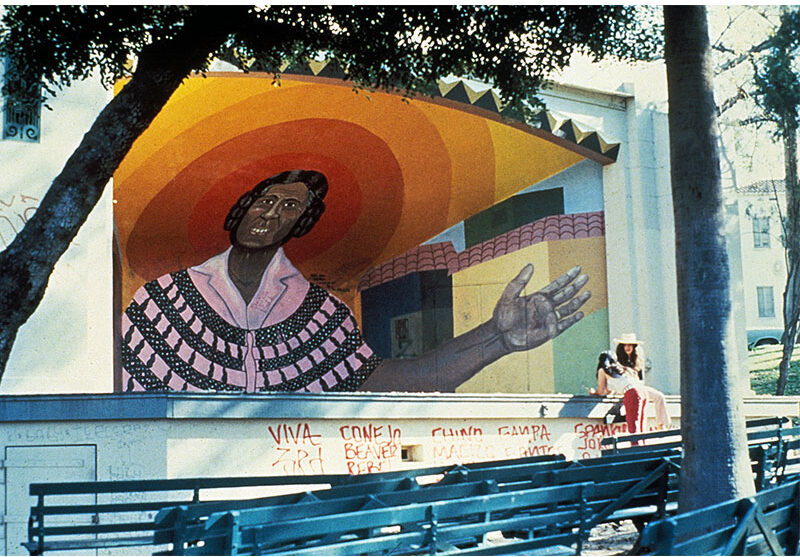
“Mi Abuelita” (My Grandmother) (1970)
In the summer of 1970, Baca brought together twenty young people from four rival gangs in Boyle Heights to paint murals. She had gotten to know them over time, and she wanted to try to create “a public consciousness about people who are, in fact, the majority of the population but who are not represented in any visual way.” The group chose the name Las Vistas Nuevas (New Views). Their first project, “Mi Abuelita” (My Grandmother) (1970) (25’x35’) (acrylic on concrete) was a mural painted on three walls of the outdoor stage in Hollenbeck Park. The mural was based on a photograph of Baca’s grandmother. Her arm outstretched, she offers a welcoming smile and hug to all. Her hairstyle, clothing, the simple city scape, and the sunshine complete the story. Baca chose the simplified drawing and coloring of the Mexican mural tradition she had seen, revered, and studied. Baca stated, “This work recognized the primary position of the matriarch in Mexican families. It also marked the first step in the development of a unique collective process that employs art to mediate between rival gang members competing for public space and public identity.”
Baca’s grandmother was a major figure in the community. “But my grandmother was indigenous and she looked Apache,” said Baca. She was a curanderismo, a Hispanic, indigenous, Catholic, and folk healer, who used herbs, rituals, prayers, spiritual cleansings, and massages to achieve healing. People of the community came to her for healing of bodies and souls. The mural was a great success and Baca stated, “Everybody related to it. People brought candles to that site. For 12 years people put flowers at the base of the grandmother image.”
During the painting of the mural, the local police feared that rival gangs might react with violence. Baca posted lookouts from the team who would whistle if they saw danger coming from gangs or the police. Complaints came in. Baca wrote, “After seeing the progress and team members working so well with each other…the city was amazed at the work I was doing, making murals with kids who scared directors out of neighborhood centers.”
Aa a result of the success of the mural project, Baca was named director of a new citywide mural program. She could choose the sites, design, and supervise their creation. Las Vistas Nuevas members were hired to work with Baca. The group would paint over 500 murals.
In 1976 Baca, Christina Schlesinger, and Donna Deitch created the Social and Public Art Resource Center (SPARC), a non-profit organization in Venice, California. Its mission is “to produce, preserve, and promote activist and socially relevant artwork; to devise and innovate excellent art pieces through participatory processes; and ultimately, to foster artistic collaborations that empower communities who face marginalization or discrimination.” Baca commented, “I really liked the idea that the work could not be owned by anyone. So, it wasn’t going to be interesting to the rich or to the wealthy, and it didn’t have to meet the caveats of art that museums would be interested in.’’
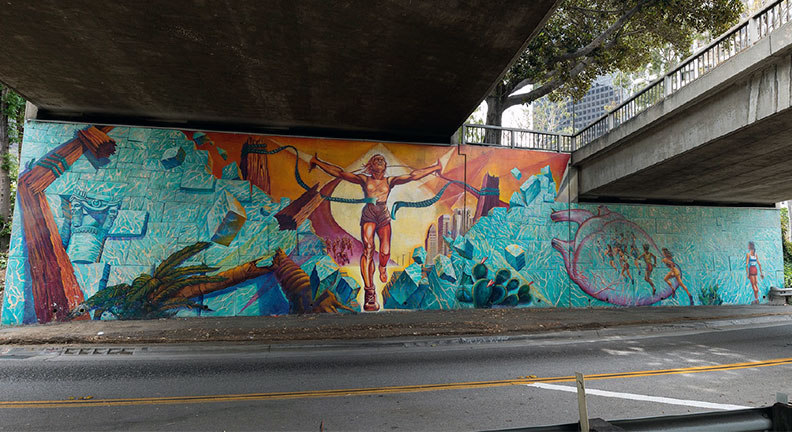
“Hitting the Wall” (1984)
Baca’s art included themes of women’s rights. “Hitting the Wall” (1984) (25’x100’) was commissioned by the Los Angeles Olympic Committee. It used the opportunity of the 1984 Summer Olympics to highlight the City by commissioning ten murals by Los Angeles artists, one of them, Judy Baca. The ‘84 Olympics was the first to include a women’s marathon, earlier considered to be too dangerous for women even to attempt. Baca interviewed several marathon runners, and their stories about “hitting the wall” at 20 and 24 miles became her subject. They feared their muscles would run out of stored energy and begin to shut down. Completing the race relied on their mental strength. The large heart at the right side of the mural is a symbol of the heavy beating of the runner’s heart.
The 25-foot-tall runner breaks through the green finish line tape and the turquoise wall, symbolically breaking down barriers to success. The Aztecs believed the Sun was made of turquoise and was associated with Xiuhtecuhtli, the primordial god of creation, the Turquoise Lord, lord of celestial cycles, renewal, fire, rain, and fertility. Turquoise was used in the making of weapons, beads, and ritual objects. The city of Los Angeles can be seen on the right, behind the Finish Line. At the left the Tower of Babel falls, a reference to the universal understanding that females should not be limited.
Robert Fitzpatrick, director of the Olympic Arts Festival, chose the location of the ten murals on the ten downtown freeway exits into Los Angeles because the path to the ancient Greek Olympics was along a major entryway to Athens lined with statues. Artists received $15,000 each for their projects. They paid thousands of dollars for insurance and barriers to protect painters and drivers over the nine months required to complete the project. Baca’s “Hitting the Wall” was located at the 4th street off-ramp of route 110. The exit led to the Music Center.
Tagging the murals was a big problem. Baca and SPARC restored this mural several times. Tagging and over painting outside art work is an on-going issue. Talented graffiti artists deplored the situation, stating “We are all artists. These taggers show a lack of respect for other people’s work and a lack of understanding that murals are a part of the tradition that paved the way for us.” On May 2, 2024, the Los Angeles Country Museum purchased a group of Baca drawings for “Hitting the Wall” for the permanent collection. These were the first Baca works to enter the Museum’s collection. That purchase is directly connected to the 2028 Los Angeles Olympics sponsors recognition of the mural as a significant art form in Los Angelos.
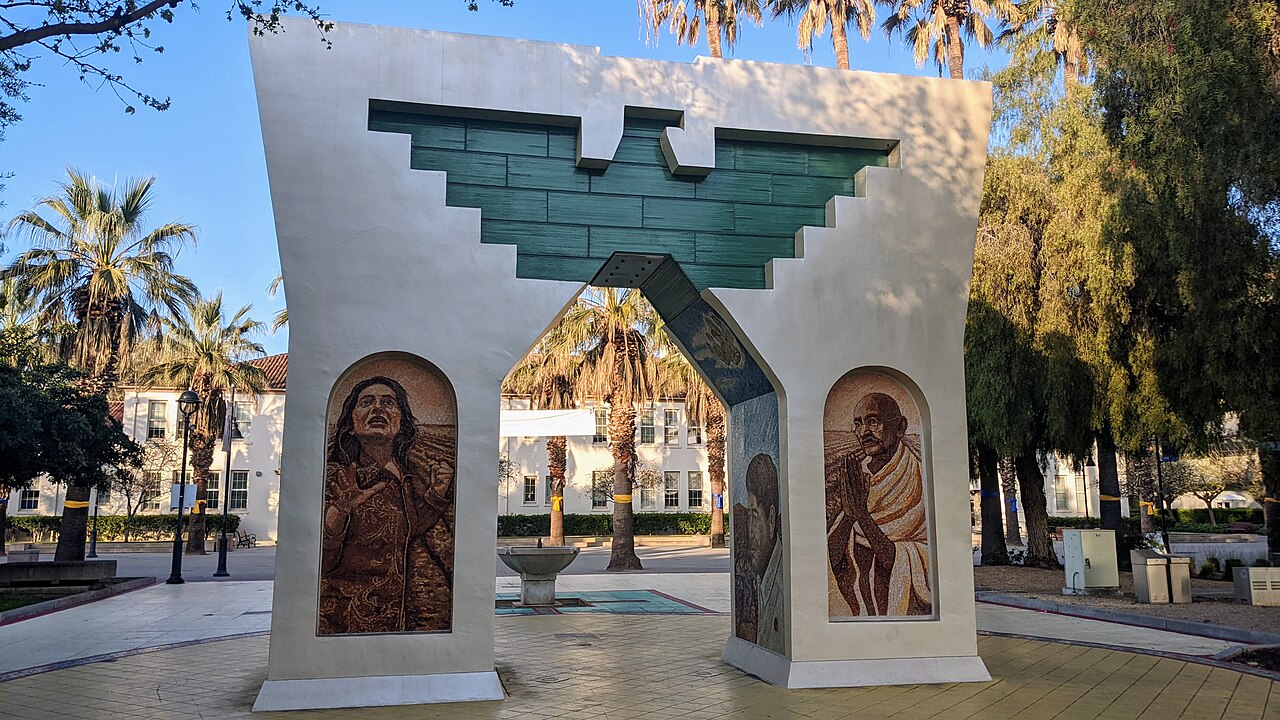
“Arch of Dignity, Equality, and Justice” (2008)
“Arch of Dignity, Equality, and Justice” (2008) was commissioned by San Jose State University as a memorial to Ceasar Chaves, American labor leader and civil rights activist. This was not to be a traditional monument to a fallen soldier, but as Baca stated, “It is not Cesar’s personality that is to be remembered, but his ideals and beliefs.” The arch opening was designed to resemble the Mayan arch with sides slanted toward the center. It was the doorway opening to temples, tombs, and ceremonial buildings. Placed at the top of the arch is a turquoise glass mosaic eagle, the symbol of the United Farm Workers. A ton of glass was specially ordered from Cuernavaca, Mexico, for the mural. Mosaic portraits of Mahatma Gandhi and Dolores Huerta can be seen in this view. Baca included Gandhi to represent non-violence in the fight for human rights. Dolores Huerta was co-founder of the United Farm Workers and an activist and advocate for farm workers, particularly women. She worked to develop legislation for equal human rights. The figures in the niches (each 4’ by 9’) on the other side of the arch are depictions of male and female farmworkers who picked crops in the Salinas Valley.
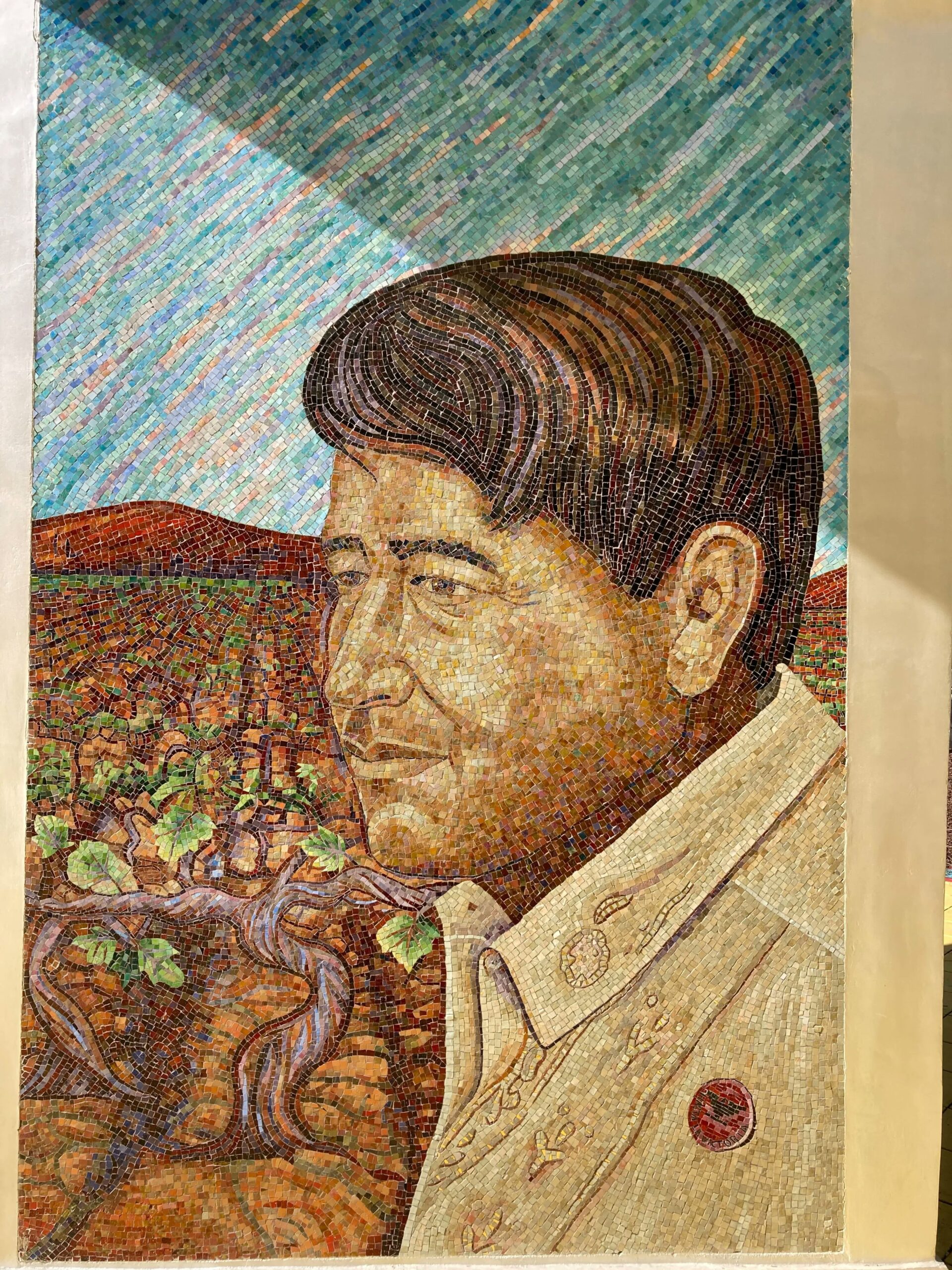
“Ceasar Chaves”
Inside the arch one mosaic is a depiction of Ceasar Chaves contemplating the furrowed field and green leaves of a flourishing crop, also where the boycotts took place. On his shirt is the symbol of the United Farm Workers, a red pin with a black eagle. Above his head, on the slanted panel (not shown), is the Virgin of Guadalupe, the patron saint of Mexico. Mary appeared in 1531 to an Aztec Christian named Juan Diego near what is now Mexico City. The Virgin blesses Chaves. Beneath her image is a skull, representing the death of farmworkers caused by pesticides. Across from Chaves is Robert Kennedy (not shown). On March 10, 1968, Chaves broke a 25-day protest fast and accepted bread from Senator Kennedy. In his speech Kennedy referred to the day as an “historic occasion” and said they were “locked in the struggle for justice for the farmworkers, and the struggle for justice for the Spanish-speaking Americans.” The arch stands next to the Student Union Building to ensure people walk through it. Chaves stated, “A symbol is an important thing, that is why we chose an Aztec eagle. It gives pride…When people see it, they know it means dignity.”
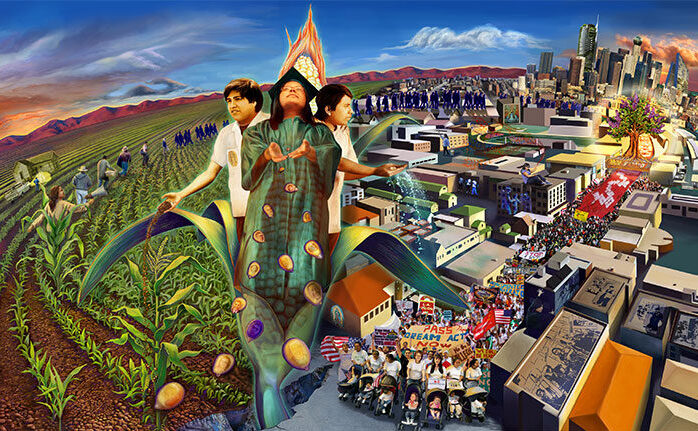
#5 “Gente de la Maiz” (People of the Corn) (2012)
“Gente de la Maiz” (People of the Corn) (2012) (18’x33’) was commissioned by Maria Elena Durazo of the AFL-CIO in collaboration with the UCLA Labor Center and the Miquel Contreras Learning Center, and SPARC. The mural celebrates the work of labor leader Miguel Contreras (1952-2005), who brought Latino immigrant workers into the AFL-CIO, making major improvements in their lives. Baca designed the mural with the help of high school students from the Contreras Center. Baca and the students conducted interviews in their communities in order to tell the story of the struggle of documented and undocumented immigrants to overcome obstacles and to achieve success. The project was completed in twenty weeks, and the mural was placed in the cafeteria of the Miguel Contreras Learning Complex.
The major figure is Karina Perez Alvarado, who met Baca when she was a high school senior. She showed Baca some of her sketches, and Baca encouraged her to enroll in one of Baca’s classes at UCLA. Baca taught art classes at UC Irvine from 1980 until 1996, and then at UCLA from 2002 until 2018. She was a professor of Chicano Studies in the World Arts and Cultures Department. She also taught at the Miguel Contreras Center. In the piece, Alvarado wears a cap and gown, and she raises her head and hands in thanks. She took Baca’s advice. She graduated from UCLA, and she is a Contreras alumna, who also works at the Contreras Center. She spoke about the role of education in her life: “It’s an empowerment that never dies and something I carry with me wherever I go. If children can learn that ‘my experience matters and I can share my experience through art and something visual’ those kids are going to be forever influenced and empowered. I think that’s a beautiful thing Judy is doing.”
Alvarado stands at the center of the large ear of corn. To her left, representing agriculture, is a field where corn is being harvested. To her right is an expansive view of Los Angeles where she can now take her place, but not without continued struggle. In the foreground, women march peacefully in support of the passage of the Dream Act, legislation to create a pathway to citizenship for undocumented immigrants who came to American as children.
Two male students also stand with Alvarado on the corn cob. One student sprinkles a handful of corn seeds. The other pours water from his hands. Kernels of corn and a halo are behind Alvarado’s head. Large kernels of corn fall from her hands, and her graduation gown resembles kernels of corn in the cob. The past, the present, and hope for future are connected.
October is designated Spanish Heritage Month. As a Chicana, Baca’s choice of designation, she continues to work for social justice by creating collaborations that bring disparate groups of people together.
Beverly Hall Smith was a professor of art history for 40 years. Since retiring to Chestertown with her husband Kurt in 2014, she has taught art history classes at WC-ALL and the Institute of Adult Learning, Centreville. An artist, she sometimes exhibits work at River Arts. She also paints sets for the Garfield Theater in Chesterto



Write a Letter to the Editor on this Article
We encourage readers to offer their point of view on this article by submitting the following form. Editing is sometimes necessary and is done at the discretion of the editorial staff.